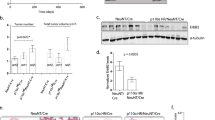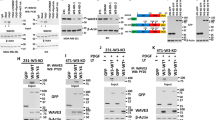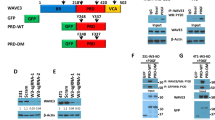Abstract
Relatively little is known about the molecular mechanisms of tumor promotion/progression in mammary carcinogenesis. Increased protein kinase C (PKC) activity is known to promote tumor formation in several tissues; however, its role in mammary carcinogenesis is not yet known. To determine if individual PKCs may selectively regulate properties of mammary tumor cells, we compared PKC isozyme levels in mammary tumor cell lines with low, moderate and high metastatic potential. All three cell lines expressed α, δ, ε and ζ PKCs; however, PKCδ levels were relatively increased in the highly metastatic cells. To determine if increased PKCδ could contribute to promotion/progression, we overexpressed PKCδ in the low and moderately metastatic cell lines. PKCδ overexpression had no significant effect on growth of adherent cells, but significantly increased anchorage-independent growth. Conversely, expressing the regulatory domain of PKCδ (RDδ), a putative PKCδ inhibitory fragment, inhibited anchorage-independent growth. The efficacy of RDδ as a PKCδ inhibitor was demonstrated by showing that RDδ selectively interfered with PKCδ subcellular location and significantly interfered with phosphorylation of the PKC cytoskeletal substrate, adducin. PKC-dependent phosphorylation of cytoskeletal substrate proteins, such as adducin, provides a mechanistic link between increased PKCδ activity and phenotypic changes in cytoskeletal-dependent processes such as migration and attachment, two processes that are relevant to metastatic potential. The reciprocal growth effects of expressing PKCδ and RDδ as gain and loss of function constructs, respectively, provide strong evidence that PKCδ regulates processes important for anchorage-independent growth in these mammary tumor cells.
This is a preview of subscription content, access via your institution
Access options
Subscribe to this journal
Receive 50 print issues and online access
$259.00 per year
only $5.18 per issue
Buy this article
- Purchase on Springer Link
- Instant access to full article PDF
Prices may be subject to local taxes which are calculated during checkout








Similar content being viewed by others
Abbreviations
- DAG:
-
diacylglycerol
- HA:
-
hemagglutinin
- MT:
-
mammary tumor
- MTT:
-
4,5-dimethylthiazol-2,5-diphenyltetrazolium bromide
- PBS:
-
phosphate-buffered saline
- PKC:
-
protein kinase C
- RD:
-
regulatory domain
- wt:
-
wild type
- Zn:
-
zinc chloride
References
Bornancin F and Parker PJ . 1997 J. Biol. Chem. 272: 3544–3549.
Cacace AM, Guadagno SN, Krauss RS, Fabbro D and Weinstein IB . 1993 Oncogene 8: 2095–2104.
Chapline C, Ramsay K, Klauck T and Jaken S. . (1993) J. Biol. Chem. 268: 6858–6861.
Dekker LV and Parker PJ. . 1997 J. Biol. Chem. 272: 12747–12753.
Denning MF, Dlugosz AA, Threadgill DW, Magnuson T and Yuspa SH. . 1996 J. Biol. Chem. 271: 5325–5331.
Dong L, Chapline C, Mousseau B, Fowler L, Ramsay K, Stevens JL and Jaken S. . 1995 J. Biol. Chem. 270: 25534–25540.
Edwards AS, Faux MC, Scott JD and Newton AC. . 1999 J. Biol. Chem. 274: 6461–6468.
Fowler L, Dong LQ, Van de Water B, Bowes R, Stevens JL and Jaken S. . 1998a Cell Growth Diff. 9: 177–184.
Fowler L, Everitt JL, Stevens JL and Jaken S. . 1998b Cell Growth Diff. 9: 405–413.
Hansen MB, Nielsen SE and Berg K. . 1989 J. Immunol. Meth. 119: 203–210.
Hug H and Sarre TF. . 1993 Biochem. J. 291: 329–343.
Jaken S. . (1997) In: Parker PJ and Dekker L (eds). Protein kinase. RG Landes: Georgetown pp.179–188.
Kahn SM, O'Driscoll KR, Jiang W, Borner C, Xu DB, Blackwood MA, Zhang Y-J, Nomoto K and Weinstein IB. . 1994 Carcinogenesis 15: 2915–2919.
Kiley SC, Clark KJ, Goodenough M, Welch DR and Jaken S. . 1999 Cancer Res. 59: 3230–3238.
Kiley SC and Jaken S. . 1990 Mol. Endocrinol. 4: 59–68.
Leach KL, Powers EA, McGuire JC, Dong L, Kiley SC and Jaken S. . 1988 J. Biol. Chem. 263: 13223–13230.
Li W, Jiang Y-X, Zhang J, Flechner L, Kapoor V, Pierce J and Wang L-H. . 1998 MCB 18: 5888–5898.
Li W, Mischak H, Yu J-C, Wang L-M, Mushinski JF, Heidaran MA and Pierce JH. . 1994 J. Biol. Chem. 269: 2349–2352.
Li WQ, Michieli P, Alimandi M, Lorenzi MV, Wu YM, Wang LH, Heidaran MA and Pierce JH. . 1996 Oncogene 13: 731–737.
Li X, Matsuoka Y and Bennett V. . 1998 J. Biol. Chem. 273: 19329–19338.
Liao L, Hyatt SL, Chapline C and Jaken S. . 1994a Biochem. 33: 1223–1229.
Liao L, Ramsay K and Jaken S. . 1994b Cell Growth Diff. 5: 1185–1194.
Lu ZM, Hornia A, Jiang YW, Zang Q, Ohno S and Foster DA. . 1997 Mol. Cell. Biol. 17: 3418–3428.
Mischak H, Goodnight J, Kolch W, Martiny-Baron G, Schaechtle C, Kazanietz MG, Blumberg PM, Pierce JH and Mushinsk JF. . 1993 J. Biol. Chem. 268: 6090–6096.
Mochly-Rosen D and Gordon AS. . 1998 FASEB J. 12: 35–42.
Neri A, Welch D, Kawaguchi T and Nicolson GL. . 1982 JNCI 68: 507–517.
Nishizuka Y. . 1995 FASEB J. 9: 484–496.
Ogita K, Miyamoto S, Yamaguchi K, Koide H, Fujisawa N, Kikkawa U, Sahara S, Fukami Y and Nishizuka Y. . 1992 Proc. Natl. Acad. Sci. USA 89: 1592–1596.
Parissenti AM, Kirwan AF, Kim SA, Colantonio CM and Schimmer BP. . 1998 J. Biol. Chem. 273: 8940–8945.
Schaap D, Parker PJ, Bristol A, Kriz R and Knopf J. . 1989 FEBS Lett. 243: 351–357.
Van Huizen R, Miller K, Chen DM, Li Y, Lai ZC, Raab RW, Stark WS, Shortridge RD and Li M. . 1998 EMBO J. 17: 2285–2297.
Vaux DL and Weissman IL. . 1993 Mol. Cell Biol. 13: 7000–7005.
Watanabe T, Ono Y, Taniyama Y, Hazama K, Igarashi K, Ogita K, Kikkawa U and Nishizuka Y. . 1992 Proc. Natl. Acad. Sci. USA 89: 10159–10163.
Ways DK, Cook PP, Webster C and Parker PJ. . 1992 J. Biol. Chem. 267: 4799–4805.
Ways DK, Kukoly CA, DeVente J, Hooker JL, Bryant WO, Posekany KJ, Fletcher DJ, Cook PP and Parker PJ. . 1995 J. Clin. Invest. 95: 1906–1915.
Weinstein IB, Begemann M, Zhou P, Han EK, Sgambato A, Doki Y, Arber N, Ciaparrone M and Yamamoto H. . 1997 Clin. Cancer Res. 3: 2696–2702.
Weinstein IB, Lee L-S, Fisher PB, Mufson A and Yamasaki H. . 1979 J. Supramol. Structure 12: 527–540.
Welch DR, Neri A and Nicolson GL. . 1983 Invasion Metastasis 3: 65–80.
Wu SL, Staudinger J, Olson EN and Rubin CS. . 1998 J. Biol. Chem. 273: 1130–1143.
Yamaguchi K, Ogita K, Nakamura S and Nishizuka Y. . 1995 Biochem. Biophys. Res. Commun. 210: 639–647.
Yao L, Kawakami Y and Kawakami T. . 1994 Proc. Natl. Acad. Sci. USA 91: 9175–9179.
Acknowledgements
This work was supported by US Army Medical Research and Materiel Command Grant #DAMD17-94-J4312 (S Jaken), #DAMD17-96-1-6152 (DR Welch) and NIH grant CA #71604 (S Jaken). We would like to thank Katrina Ramsay, Breandan Kennedy and Betty Mousseau for their individual contributions to the evolution of the DNA constructs used in this study. Marina LaDuke and Alice Vera assisted in the preparation of figures contained within this manuscript.
Author information
Authors and Affiliations
Rights and permissions
About this article
Cite this article
Kiley, S., Clark, K., Duddy, S. et al. Increased protein kinase Cδ in mammary tumor cells: relationship to transformation and metastatic progression. Oncogene 18, 6748–6757 (1999). https://doi.org/10.1038/sj.onc.1203101
Received:
Revised:
Accepted:
Published:
Issue Date:
DOI: https://doi.org/10.1038/sj.onc.1203101
Keywords
This article is cited by
-
Protein kinase Cδ is required for ErbB2-driven mammary gland tumorigenesis and negatively correlates with prognosis in human breast cancer
Oncogene (2014)
-
Involvement of PKC delta (PKCδ) in the resistance against different doxorubicin analogs
Breast Cancer Research and Treatment (2011)
-
Protein kinase Cα suppresses the expression of STC1 in MDA-MB-231 breast cancer cells
Tumor Biology (2011)
-
PKCα expression is a marker for breast cancer aggressiveness
Molecular Cancer (2010)
-
Roles of PKC isoforms in the induction of apoptosis elicited by aberrant Ras
Oncogene (2010)



